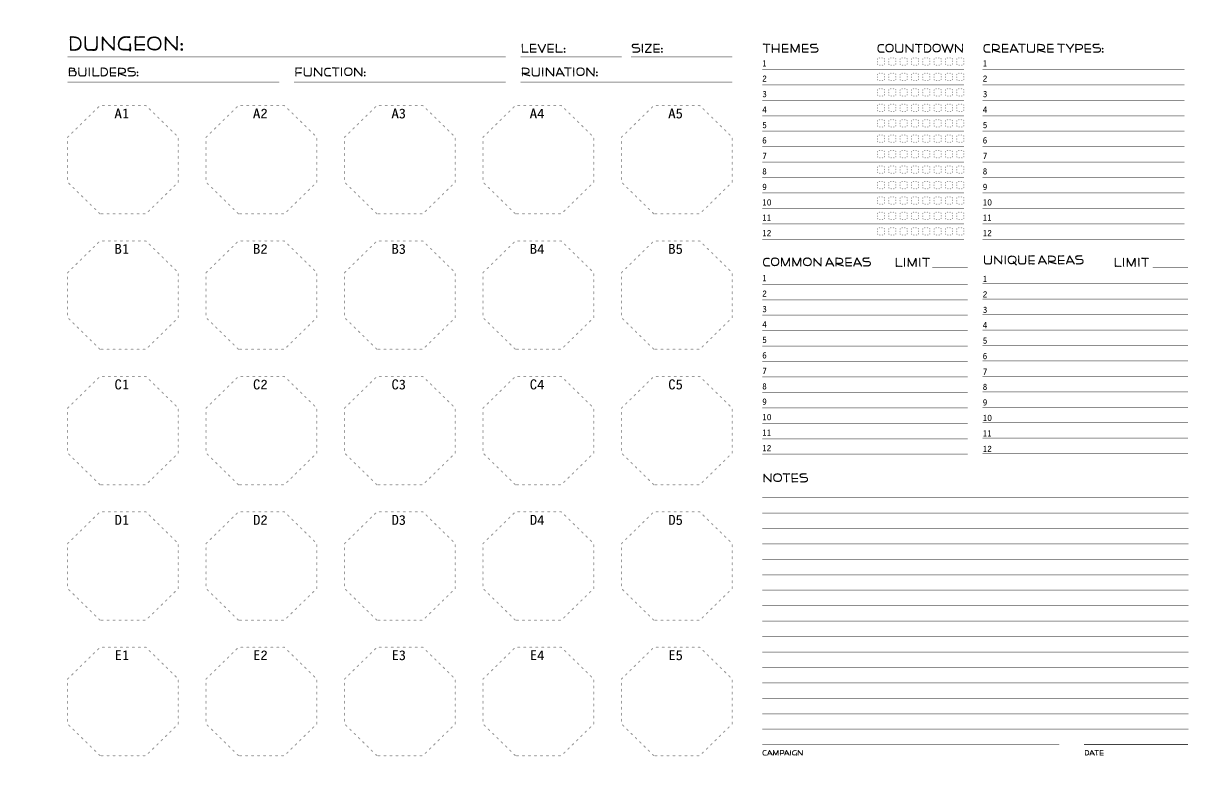
Here’s another tool we use in our “almost GM-less” Freebooters campaign. It’s a nodal dungeon record. We enter the map at a random location, roll to see what we find, then roll for the number of exits (and their directions) and repeat until the dungeon is fully explored, making notes as we go.
When a monster is encountered, we roll a d12. If the number corresponds to a monster already on the list, we re-use it! If not, the new monster is added to the end of the list.
It’s important to note that this is strictly nodal; there’s no intention to represent size, distance or anything more than rough general spatial relations. I’ll post an example of a filled-in level too.
Here’s a PDF. I print these at Staples on 11×17 card stock. They fold in the middle with room for hole punching.
http://www.mysticworks.com/freebooters/downloads/Nodal-Dungeon-Record-by-Maezar.pdf

Here’s a populated piece of a dungeon that one of my groups created.
https://lh3.googleusercontent.com/Y0613w2eEU_snV58G6AWS8zKoLBrQ43-qOVidUF12cihDk5uRO0zTn34qIVt4HoBWoHzyunkK6z-kDxCnDtz-cC6sfjRss4ZOTE=s0
How do you run puzzles without a GM? Wouldn’t everyone know the solution?
d8 for exit directions, obviously, but what do you roll for # exits? d4?
Holy cats! This is sooooo cool.
.
Nice. I seem to recall a similar system that used index cards for notes. It made for a very modular abstract map.
Super cool.
I’m gonna have to try this soon!
Matt Horam Pretty much the only dice we ever roll are d12s and the odd d%
NUMBER OF EXITS
1. NONE
2. NONE
3. 1
4. 1
5. 1
6. 2
7. 2
8. 3
9. 3
10. 4
11. 4
12. 1d12
EXIT DIRECTION:
1. N
2. NE
3. E
4. SE
5. S
6. SW
7. W
8. NW
10. UP
11. DOWN
12. UP AND DOWN
Alasdair Lawrence We decide together what type of puzzle it is… Examples from our games have included – mechanical – idols – mirror -perception … We then decide what the stakes are for failing a try to solve it, and what it takes to make a try.
Stakes might be, “Progressively increasing burned Dexterity points.”
“Bane: group -1 forward, persisting for as many rolls as there are failed attempts.”
“HP damage, each try uses the next larger die (d2, d3, d4, d5, d6, etc.)
Solving might take, “Two consecutive successes rolling +Dex and/or +Int” or “Roll +Str and burn 1 Strength.” etc.
We decide all of that together.
Each character who wants to try will then roll, and whoever succeeds tells us what the puzzle was and how they solved it!
Often, a puzzle must be solved for the group to move forward in our dungeons.
Also, I recognize that there are a few revisions needed to the PDF. I’ll do a final version, put it on my web site, and link to it here.
.
Here’s how we handle Monsters.
1. When a die roll indicates that a monster has been encountered, we roll a d12.
2. If the corresponding slot on the Monsters list is populated, that’s what’s encountered. If it is blank, we roll a monster and add it to the list at that slot.
1s
Small dungeons might use a d6 instead of a d12.